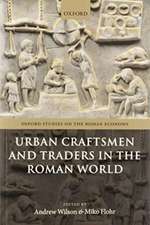The Cultural Life of Images: Visual Representation in Archaeology
Editat de Brian Leigh Molyneauxen Limba Engleză Paperback – 4 noi 2011
With subjects including prehistoric artworks, excavation illustrations, artists' impressions of ancient sites and peoples and contemporary landscapes, photographs and drawings, this study explores how pictures shape our perceptions and our expectations of the past.
This volume is not concerned with the accuracy of pictures from the past or directly about the past itself, but is interested instead in why certain subjects are selected, why they are depicted the way they are, and what effects such images have on our idea of the past. This collection constitutes a ground-breaking study in historiography which radically reassesses the ways that history can be written.
| Toate formatele și edițiile | Preț | Express |
|---|---|---|
| Paperback (1) | 414.53 lei 6-8 săpt. | |
| Taylor & Francis – 4 noi 2011 | 414.53 lei 6-8 săpt. | |
| Hardback (1) | 1010.70 lei 6-8 săpt. | |
| Taylor & Francis – 2 ian 1997 | 1010.70 lei 6-8 săpt. |
Preț: 414.53 lei
Nou
79.33€ • 82.52$ • 65.49£
Carte tipărită la comandă
Livrare economică 15-29 aprilie
Specificații
ISBN-10: 0415513448
Pagini: 292
Ilustrații: Illustrations
Dimensiuni: 156 x 234 x 16 mm
Greutate: 0.41 kg
Ediția:1
Editura: Taylor & Francis
Colecția Routledge
Locul publicării:Oxford, United Kingdom
Public țintă
Postgraduate and UndergraduateNotă biografică
Brian Leigh Molyneaux is Assistant Professor of Archaeology at the University of South Dakota.
Recenzii
'This volume is a must for anyone researching art and its role with the past.' - George Nash, 3rd Stone
Cuprins
Descriere
Pictures are often admired for their aesthetic merits but they are rarely treated as if they had as much to offer as the written word. They are often overlooked as objects of analysis themselves, and tend to be seen simply as adjuncts to the text. Images, however, are not passive, and have a direct impact that engages attention in ways independent of any specific text. Advertising, entertainment and propaganda have realised the extent of this power to shape ideas, but the scientific community has hitherto neglected the ways in which visual material conditions the ways in which we think.
With subjects including prehistoric artworks, excavation illustrations, artists' impressions of ancient sites and peoples and contemporary landscapes, photographs and drawings, this study explores how pictures shape our perceptions and our expectations of the past.
This volume is not concerned with the accuracy of pictures from the past or directly about the past itself, but is interested instead in why certain subjects are selected, why they are depicted the way they are, and what effects such images have on our idea of the past. This collection constitutes a ground-breaking study in historiography which radically reassesses the ways that history can be written.



















